Have you succumbed to the skincare buzz that is Tula Skincare? It seems that it has taken social media by storm and become a staple of many women’s skincare routine. Naturally, as a blogger in the clean beauty space, I had to test the products out for myself to see if they passed the “clean and effective” test.
Spoiler alert: That wasn’t the case!
*Suzi(Gurl Gone Green) is a participant in the Amazon Services LLC Associates Program, an affiliate advertising program designed to provide a means for sites to earn advertising fees by advertising and linking to amazon.com.
Tula Skincare
If you’re new to Tula Skincare, one of the reasons why people love their formulations is that they are powered by probiotic extracts and superfoods. It also helps that Tula’s founder, Dr. Roshini Raj is a practicing gastroenterologist who has been studying probiotics for 20 years. In fact, she released a book called, “Gut Renovation” in 2022.
Tula believes that the gut-friendly ingredients that are good for your body are also great for your skin.
True to its mission, Tula means ‘balance’ in Sanskrit.
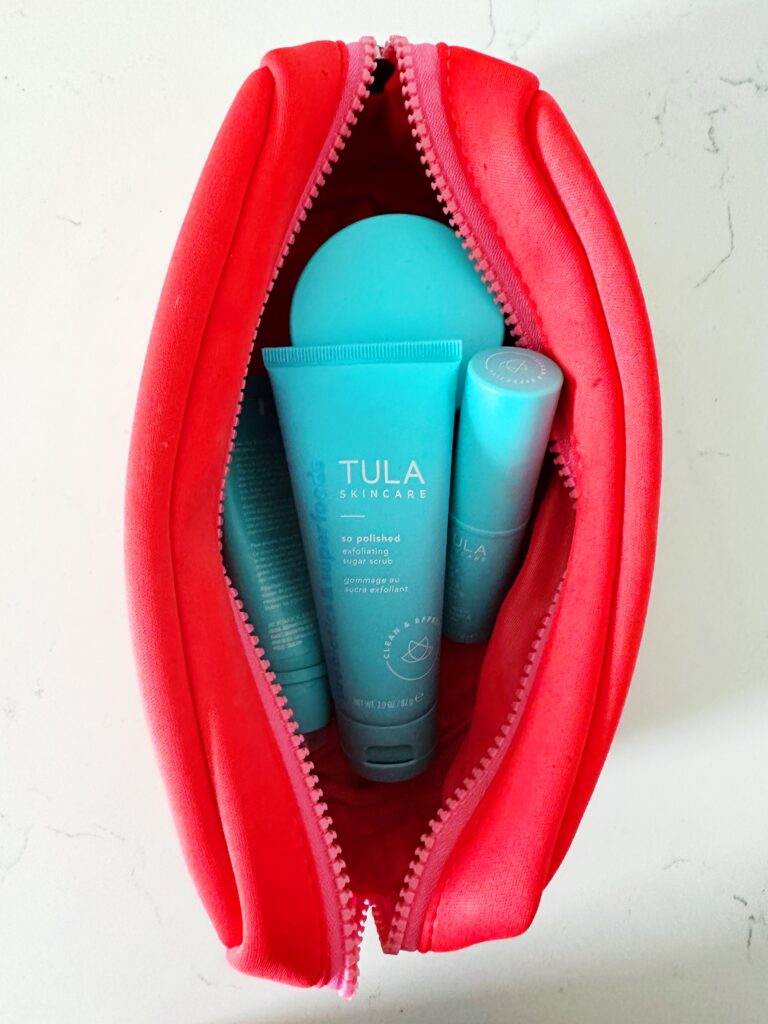
Tula Ingredients
Tula’s entire collection is dermatologist-tested and approved which means they are constantly making adjustments to provide good-for-you and results-driven formulas.
Also because Tula is constantly iterating its formulas, it’s a good idea to double check ingredient labels and not assume the ingredients have remained the same since your last purchase!
Ingredients You Won’t Find In Tula Products
Some of the ingredients you won’t find in TULA formulas:
- parabens
- phthalates
- sulfates (SLS & SLES)
- formaldehyde-releasing preservatives
- retinol
- octinoxate or oxybenzone
- mineral oil or petrolatum
There are also over 1,600 other ingredients that you won’t find in TULA products.
Related Content: 18 Best Clean Skincare Brands
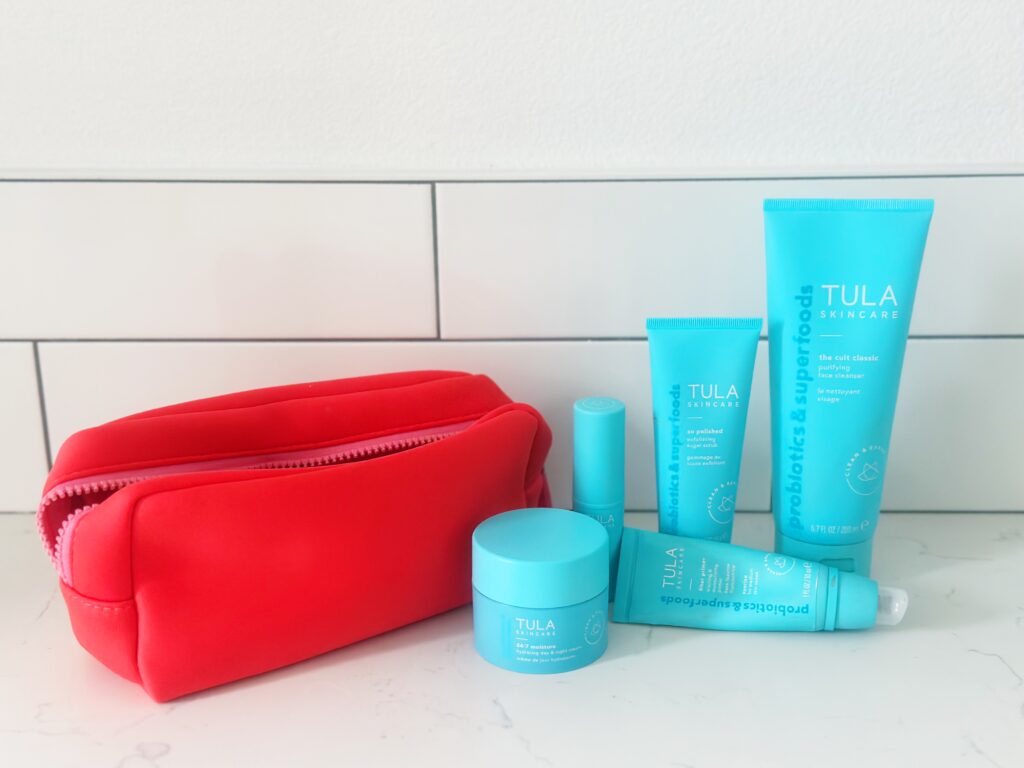
Questionable Ingredients Found In Tula Products
A list of ingredients that a brand doesn’t use is great and all. But what really matters is what they choose to use in their formulations. And, unfortunately, Tula uses some ingredients that I don’t love:
Fragrance – This is definitely a questionable ingredient especially since there’s no mention of it being from a natural origin and unfortunately it is found in almost all of Tula’s products. Lab made synthetic fragrances can be safe, if they are not made of petroleum by-products. When a product lists fragrance as an ingredient, it can be an umbrella for a number of ingredients.1
Related Content: Best Clean & Natural Perfumes
Phenoxyethanol – If it’s from a clean source it’s fine, but if it doesn’t come from a clean source then it can be contaminated with 1,4 dioxane, which is a known carcinogen.2
Blue 1 (CI 42090) and Yellow 5 (Cl 19140) – Many of the dyes or aluminum lake colors are produced synthetically from coal tar or petroleum.3
Dimethicone – Can irritate skin and disrupt healthy skin function.
Disteareth-75 IPDI– Can be contaminated with 1,4 dioxane.
Polysorbate 20– Can be contaminated with 1,4 dioxane through ethylene oxide.
PEG-120 Methyl Glucose Dioleate– This is likely contaminated with 1,4 dioxane from ethylene oxide.
Styrene/Acrylates Copolymer– Styrene can be contaminated and are carcinogenic.
Sodium Hydroxide– Can be an irritant to the skin.
Oleth-20– Can be contaminated with ethylene oxide which produces 1,4 dioxane a known carcinogen.
These ingredients are called out below in the product reviews.
Is Tula Really A Clean Brand?
Everyone has a different standard of clean beauty but because of the questionable ingredients listed above, I wouldn’t consider Tula to be a top tier clean brand, however, let me emphasize that it is a better option in comparison to conventional beauty brands.
Tula operates by three core principles in its quest to provide clean and effective formulas.
- Clean ingredients
- Transparency
- No judgment
They use beauty authorities and industry experts in the clean beauty space along with European cosmetic standards to determine what ingredients go into their formulas. Tula products have been named Clean at Sephora and are a part of Ulta Beauty’s Conscious Beauty Collection.
Tula Skincare Review
**Prices were accurate as of publish date and are subject to change**
The Cult Classic Purifying Face Cleanser
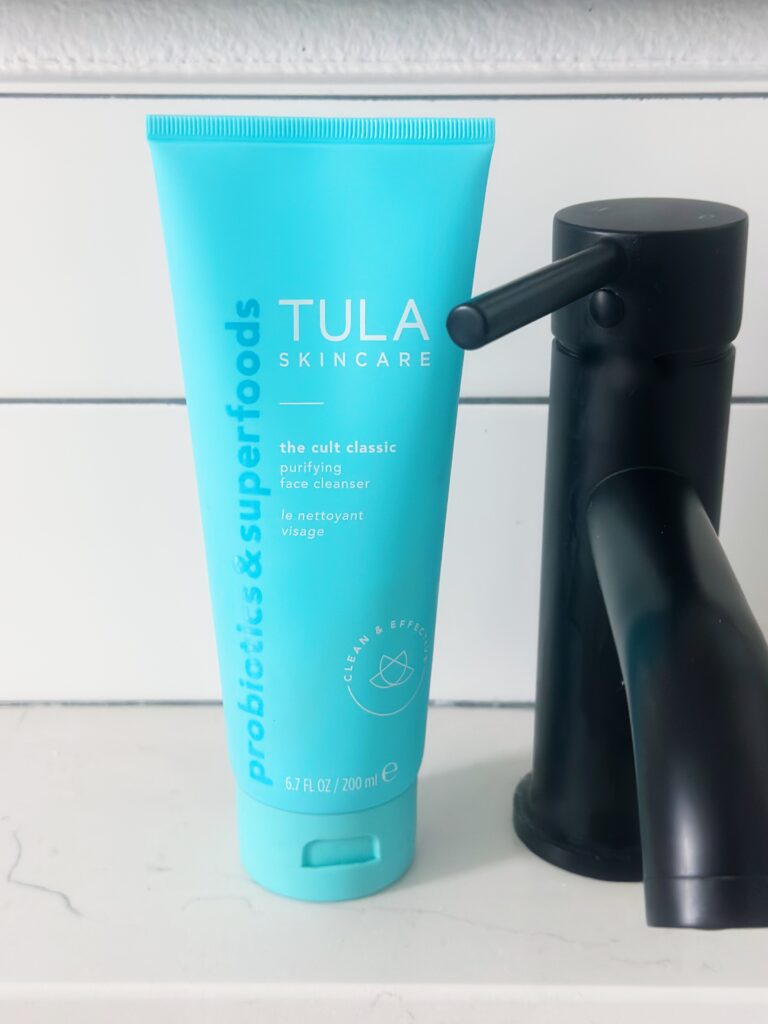
This gel cleanser is the most popular cleanser in the U.S. It says it removes makeup and dirt while also purifying and balancing skin with prebiotics, probiotic extracts and turmeric. Read on to see what I thought.
Ingredients
Aqua/Water/Eau, Disodium Laureth Sulfosuccinate, Sodium Hydroxypropylsulfonate Laurylglucoside Crosspolymer, Lauryl Glucoside, Sodium Lauryl Sulfoacetate, Sodium Chloride, Disteareth-75 IPDI, Bifida Ferment Lysate, Hydrolyzed Rice Protein, Curcuma Longa (Turmeric) Root Extract, Camellia Sinensis (Green Tea) Leaf Extract, Vaccinium Angustifolium (Blueberry) Fruit Extract, Cichorium Intybus (Chicory) Root Extract, Camelina Sativa Seed Oil, Lactose, Lactis proteinum/Milk Protein/Protéine du lait, Yogurt Powder, Olus Oil/Vegetable Oil/Huile végétale, Tocopheryl Acetate, Ascorbyl Palmitate, Panthenol, Carthamus Tinctorius (Safflower) Seed Oil, Polysorbate 20, Butylene Glycol, Inulin, Pentylene Glycol, Caprylyl Glycol, Coco-Glucoside, Hydroxyethyl Acrylate/Sodium Acryloyldimethyl Taurate Copolymer, Ethylhexylglycerin, PEG-120 Methyl Glucose Dioleate, Styrene/Acrylates Copolymer, Sorbitan Isostearate, Trisodium Ethylenediamine Disuccinate, Glutaral, Glycerin, Citric Acid, Sodium Hydroxide, Sorbic Acid, Phenoxyethanol, Benzoic Acid, Phenethyl Alcohol, Fragrance (Parfum), Alpha-Isomethyl Ionone, Benzyl Benzoate, Citronellol, Hexyl Cinnamal, Limonene, Linalool
Questionable Ingredients
Phenoxyethanol and Fragrance. But it doesn’t stop there. Polysorbate 20 can be contaminated as well as PEG-120 Methyl Glucose Dioleate, Styrene/Acrylates Copolymer. There’s so many questionable ingredients!
Cost
$24
Review
It felt like a traditional gel cleanser when I initially used it on my face. After using it my skin felt dry and unbalanced. It also smelled like cleaning products. It didn’t remove all my eye makeup either. I was very unimpressed. From the ingredient list to the actual performance. Not something I would recommend or use myself.
So Polished Exfoliating Sugar Scrub
This scrub brightens, smooths, and renews skin with probiotic extracts and superfoods like sugar, pineapple and papaya. It was also named the Best Facial Scrub by Allure 2020 Best of Beauty Awards.
Ingredients
Sucrose, Propylene Glycol Dicaprylate/Dicaprate, Octyldodecanol, PEG-7 Glyceryl Cocoate, Mangifera Indica (Mango) Seed Butter, Candelilla Cera/Euphorbia Cerifera (Candelilla) Wax/Cire de Candelilla, Disteardimonium Hectorite, Lactococcus Ferment Lysate, Bromelain, Papain, Lactic Acid, Carica Papaya (Papaya) Fruit Extract, Citrus Limon (Lemon) Fruit Extract, Ananas Sativus (Pineapple) Fruit Extract, Vitis Vinifera (Grape) Fruit Extract, Tocopheryl Acetate, Aqua/Water/Eau, Glycerin, Propylene Carbonate, Butylene Glycol, Sodium Chloride, Sodium Benzoate, Phenoxyethanol, Fragrance/Parfum, Limonene, Benzyl Salicylate, Butylphenyl Methylpropional, PEG-7 Glyceryl Cocoate
Questionable Ingredients
Phenoxyethanol and Fragrance. It doesn’t stop there though. It also has PEGs in the formula, a big red flag for me when it comes to formulations.
Cost
$34
Review
It did give my skin a good exfoliation and left it feeling smooth. But I’m not a fan of the ingredient list. So many red flags and ingredients I wouldn’t use.
24-7 Moisture Hydrating Day & Night Cream
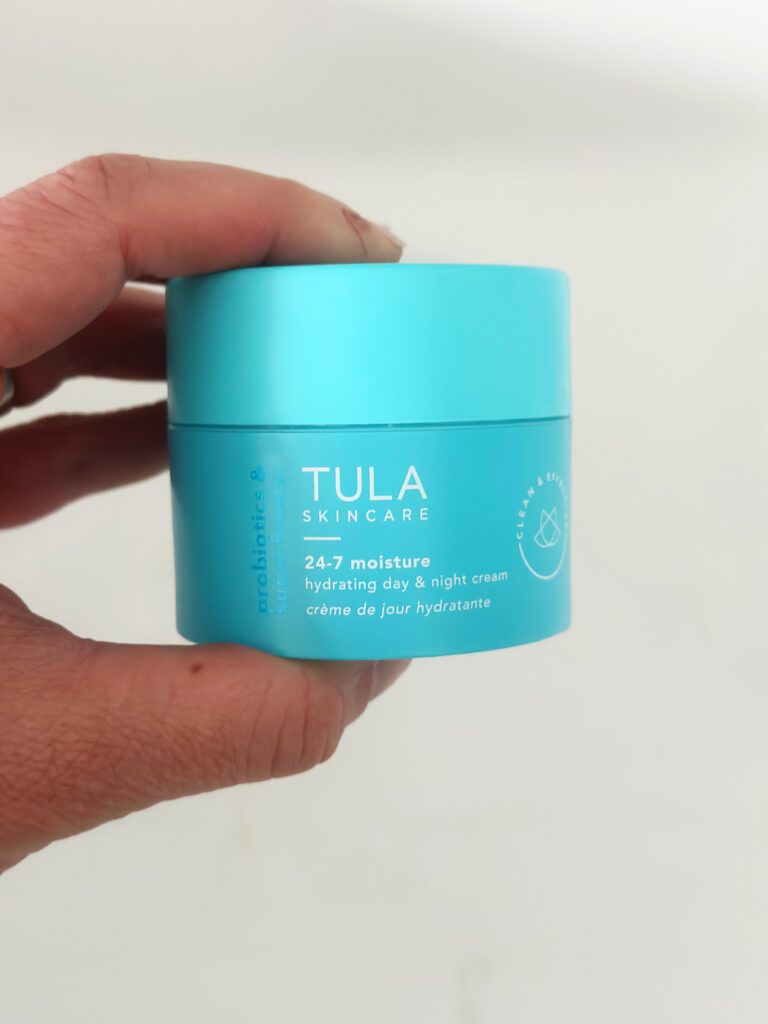
This dynamic non-comedogenic day and night cream provides lightweight all-day hydration. Squalane and peptides leave skin plump and glowing. Keep reading to see if it lived up to the hype.
Ingredients
Aqua/Water/Eau, Ethylhexyl Palmitate, Squalane, Glycerin, Caprylic/Capric Triglyceride, Cetyl Alcohol, Dimethicone, Hydrogenated Vegetable Oil, Lactococcus Ferment Lysate, Glyceryl Stearate, PEG-100 Stearate, Bifida Ferment Lysate, Lactose, Lactobacillus, Lactobacillus Ferment, Lactis proteinum/Milk Protein/Protéine du lait, Hydrolyzed Rice Protein, Collagen Amino Acids, Sodium Hyaluronate, Lactic Acid, Cichorium Intybus (Chicory) Root Extract, Alpha-Glucan Oligosaccharide, Vaccinium Angustifolium (Blueberry) Fruit Extract, Olus Oil/Vegetable Oil/Huile végétale, Camelina Sativa Seed Oil, Camellia Sinensis Leaf Extract, Curcuma Longa (Turmeric) Root Extract, Tocopheryl Acetate, Ascorbyl Palmitate, Olea Europaea (Olive) Fruit Oil, Pyrus Malus (Apple) Fruit Extract, Citrullus Lanatus (Watermelon) Fruit Extract, Lens Esculenta (Lentil) Fruit Extract, Inulin, Leuconostoc/Radish Root Ferment Filtrate, Beta Vulgaris (Beet) Root Extract/Beta Vulgaris/Extrait de racine de betterave, Polymnia Sonchifolia Root Juice, Sodium Lactate, Sodium PCA, Carbomer, Sodium Hydroxide, Pentylene Glycol, Ethylhexylglycerin, Stearyl Alcohol, Citric Acid, Phenethyl Alcohol, Sodium Benzoate, Potassium Sorbate, Phenoxyethanol, Trisodium Ethylenediamine Disuccinate, Sodium Chloride, Butylene Glycol, 1,2-Hexanediol, Maltodextrin, Fragrance (Parfum), Alpha-Isomethyl Ionone, Benzyl benzoate, Hexyl Cinnamal, Linaloo
Questionable Ingredients
Dimethicone, Phenoxyethanol, Fragrance
Cost
$58
Review
I was very eager to test out this moisturizer as I had read so many positive reviews. However, I was disappointed after using it. It didn’t perform as I had hoped it would. It left my skin feeling dry within a matter of minutes. Not moisturizing enough at all. And yes, you guessed it, not a fan of the ingredient list. Wouldn’t purchase or recommend.
Filter Primer Blurring and Moisturizing Primer (sheerly tinted)
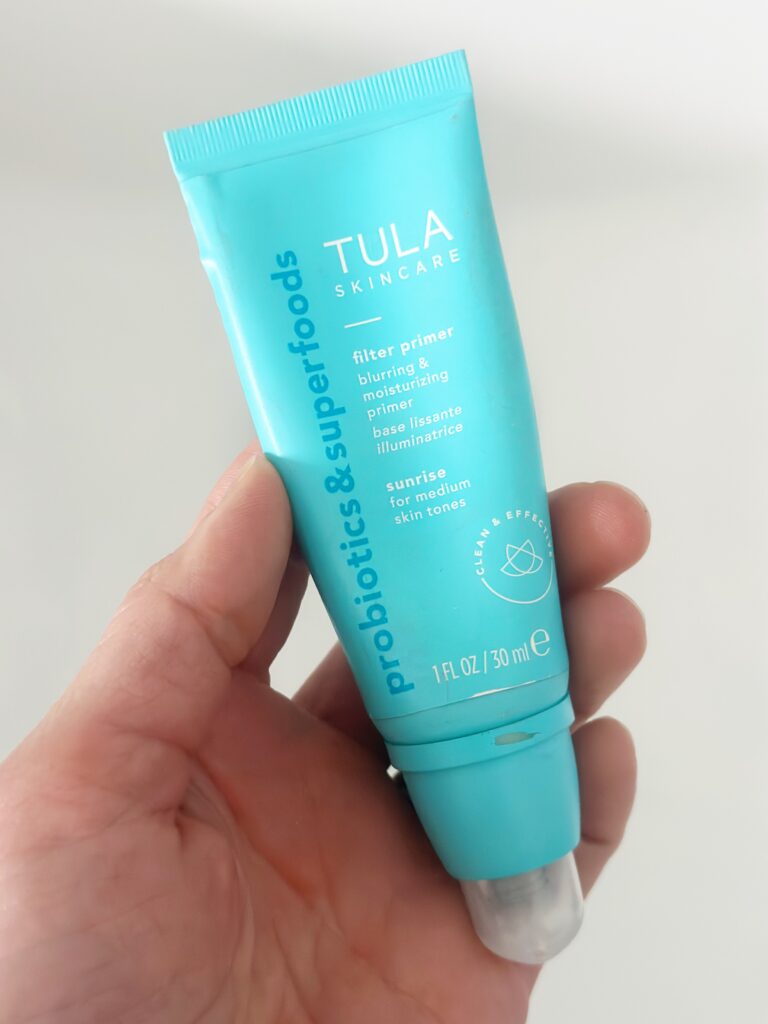
This all-in-1 moisturizing primer provides sheer coverage and evens out skin tone. The active ingredients behind this blurring and skin smoothing powerhouse are S6 Pro Complex™, licorice, butterfly bush, and chia seeds. You can use it as a primer or in place of foundation for a naturally flawless look. Keep reading to see how it held up.
Ingredients
Aqua/Water/Eau, Isododecane, Cyclopentasiloxane, Phenyl Trimethicone, Dimethicone, Ethylhexyl Palmitate, Cyclohexasiloxane, Glycerin, PEG-10 Dimethicone, PEG-9 Polydimethylsiloxyethyl Dimethicone, Cetyl PEG/PPG-10/1 Dimethicone, Disteardimonium Hectorite, Lactococcus Ferment Lysate, Lactobacillus Ferment, Lactobacillus, Centella Asiatica Extract, Polygonum Cuspidatum Root Extract, Scutellaria Baicalensis Root Extract, Beta Vulgaris (Beet) Root Extract, Inulin, Camellia Sinensis Leaf Extract, Chamomilla Recutita (Matricaria) Flower Extract, Rosmarinus Officinalis (Rosemary) Leaf Extract, Alpha-Glucan Oligosaccharide, Polymnia Sonchifolia Root Juice, Glycyrrhiza Glabra (Licorice) Root Extract, Curcuma Longa (Turmeric) Root Extract, Salvia Hispanica Seed Oil, Lactic Acid, Tocopherol, Butylene Glycol, Bisabolol, Maltodextrin, 1,2-Hexandiol, Tocopheryl Acetate, Cellulose Acetate, Acrylates/Ammonium Methacrylate Copolymer, Boron Nitride, Ethylhexylglycerin, HDI/Trimethylol Hexyllactone Crosspolymer, Magnesium Stearate, Mica, Polyglyceryl-4 Isostearate, Polymethylsilsesquioxane, Propylene Carbonate, Propylene Glycol Stearate, Silica Silylate, Sodium Benzoate, Sodium Chloride, Phenoxyethanol, May Contain: +/- Titanium Dioxide (CI 77891), Iron Oxides (CI77499) Filter Primer Sunrise Aqua/Water/Eau, Isododecane, Cyclopentasiloxane, Phenyl Trimethicone,
Questionable Ingredients
Dimethicone and Phenoxyethanol.
Cost
$38
Review
Again I had high hopes for this after all the reviews and was left feeling deflated after using it. It didn’t blur my lines. It felt just like an extra layer of product on my skin that made my skin feel the same. I felt like my makeup didn’t look as good using it. It wore off quicker. It was honestly hard for me to even test the product because I didn’t want to be using the ingredients on my skin. Not a winner in my book.
Glow + Get it Cooling & Brightening Eye Balm
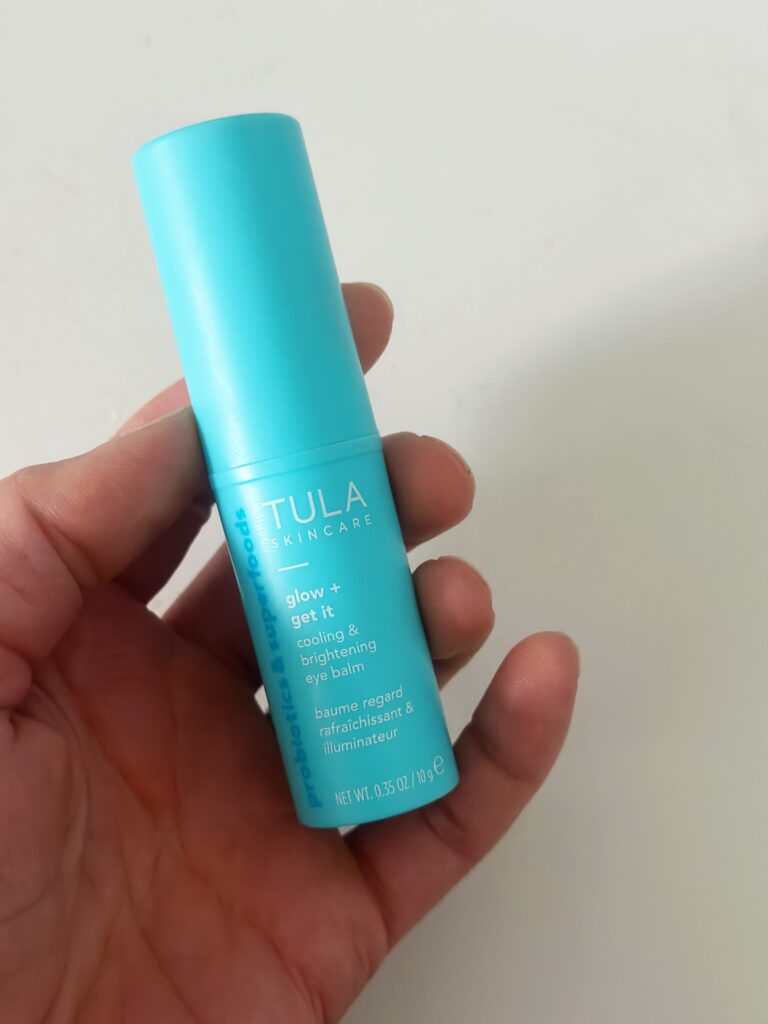
This hydrating and cooling eye balm, reduces the look of fine lines and wrinkles while also providing an instant pick-me-up. Some of the magical ingredients behind this formulation include: probiotic extracts, blueberries, hyaluronic acid, apples and watermelon. Keep reading to hear my thoughts.
Ingredients
Aqua/Water/Eau, Propanediol, Aloe Barbadensis Leaf Juice, Sodium Stearate, Xylitol, Lactococcus Ferment Lysate, Synthetic Fluorphlogopite, Oleth-20, Glycerin, Caffeine, Citrullus Lanatus (Watermelon) Fruit Extract, Lens Esculenta (Lentil) Fruit Extract, Pyrus Malus (Apple) Fruit Extract, Hyaluronic Acid, Vaccinium Angustifolium (Blueberry) Fruit Extract) Lactic Acid, Tocopherol, Sodium PCA, Diphenyl Succinate, Menthone Glycerin Acetal, Menthyl Lactate, Capryloyl Glycerin/Sebacic Acid Copolymer, Xanthan Gum, Sodium Lactate, Tin Oxide, Sodium Chloride, Ethylhexylglycerin, Phenoxyethanol, Sodium Benzoate, Potassium Sorbate, Titanium Dioxide (CI 77891), Blue 1 (CI 42090), Yellow 5 (CI 19140)
Questionable Ingredients
Phenoxyethanol, Blue 1 (CI 42090), Yellow 5 (Cl 19140).
Cost
$38
Review
This product actually was true to its description in my opinion. It helped to cool my under eye area, and left my under eye area feeling hydrated. It impressed me how light it felt but was still moisturizing. I even was able to apply this over my foundation and it worked well. The ingredients are a lot better compared to other Tula products. I still wouldn’t repurchase though because it does contain some ingredients that I wouldn’t use. I also just don’t think skincare needs to have artificial dyes in them!
Conclusion: Is Tula Skincare Worth It?
No, I don’t think Tula skincare is worth it. After having tested it out, it’s not worth the hype. I would caution anyone to read ingredient labels before buying. Also, don’t believe what any influencer says- I’m saying this as an influencer myself. I see too many people promoting this brand that don’t know ingredients or skincare products. Dig a little deeper always!
Have you tried Tula Skincare? Share your thoughts below!
If you liked this post, check out these past posts:

References
- U.S. Food and Drug Administration (2022) Fragrances in Cosmetics
- National Library of Medicine (2007) Toxicological Profile for 1,4-Dioxane
- EWG’s Skin Deep Database (2023) Fd&C Yellow 5 (Ci 19140) Aluminum Lake



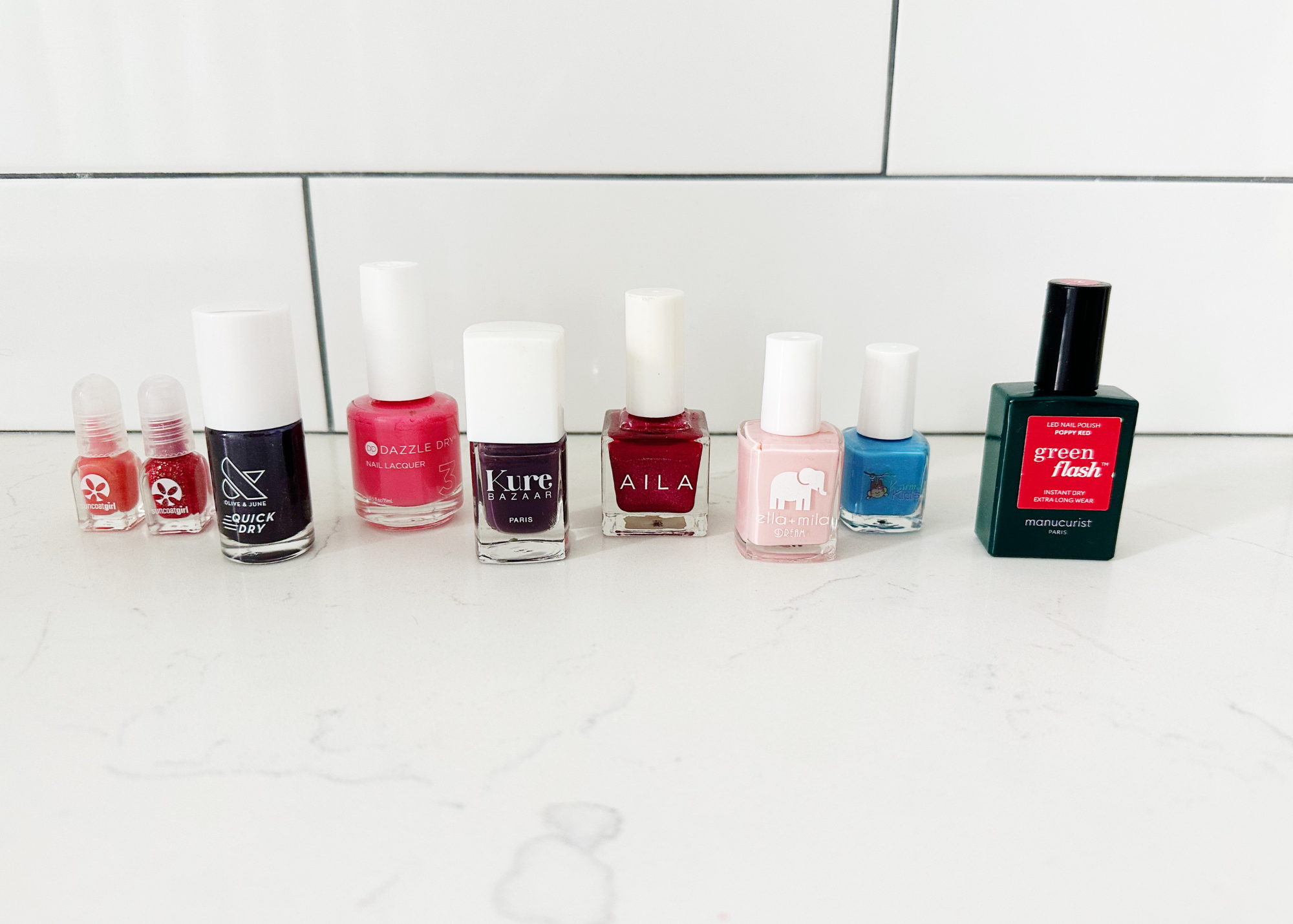
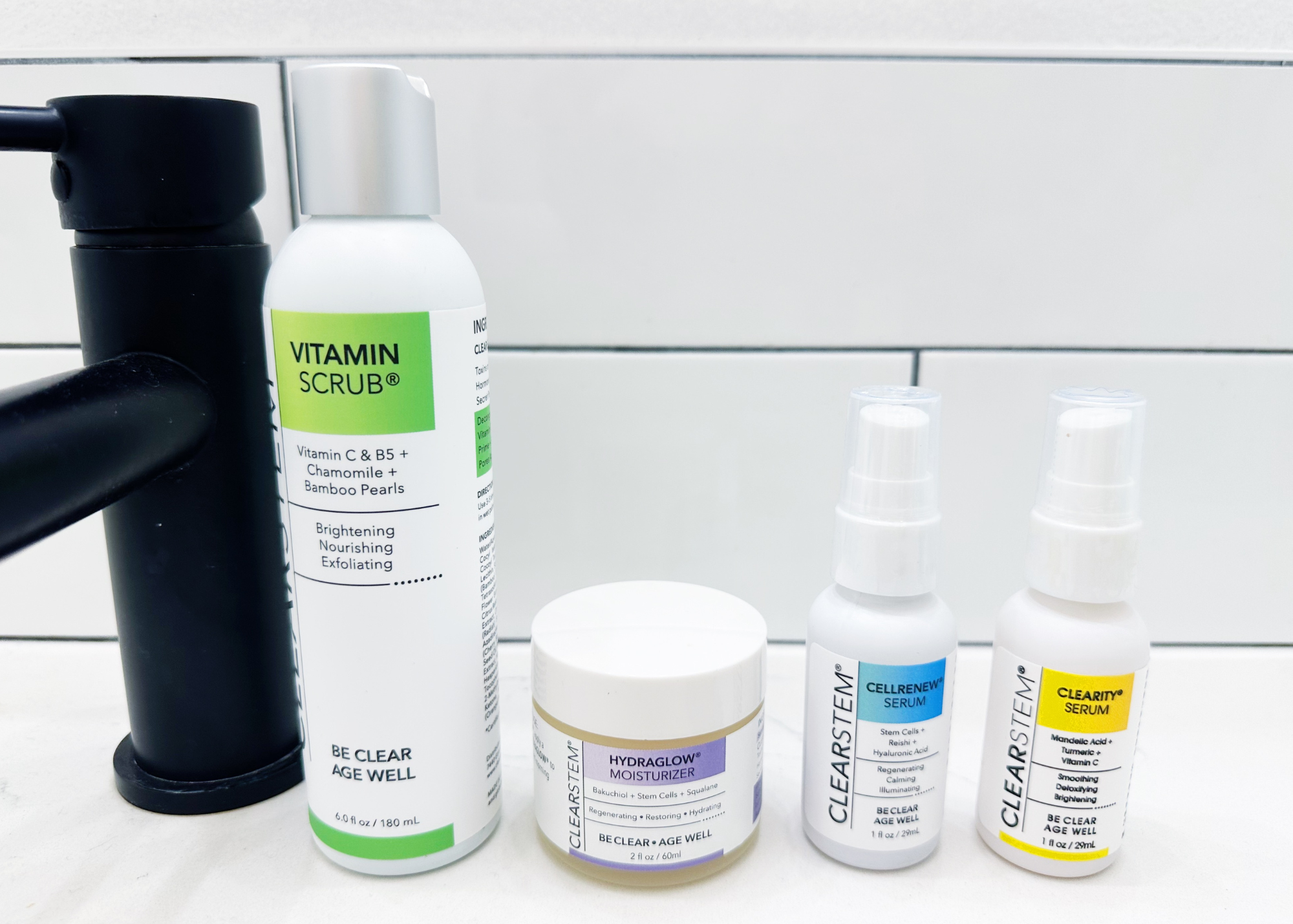
0 Comments